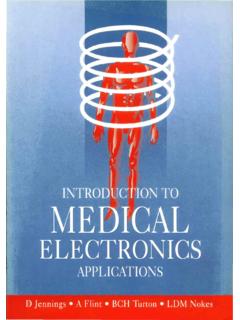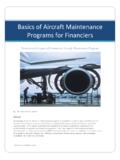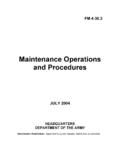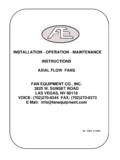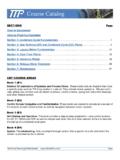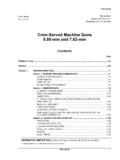Transcription of Fundamentals of Preventive Maintenance - …
1 FundamentalsofPreventiveMaintenanceThis Page Intentionally Left BlankFundamentalsofPreventiveMaintenance JOHNM. GROSSA merican Management AssociationNew York Atlanta Brussels Buenos Aires Chicago London Mexico City San Francisco Shanghai Tokyo Toronto Washington, discounts on bulk quantities of AMACOM books areavailable to corporations, professional associations, and otherorganizations. For details, contact Special Sales Department,AMACOM, a division of American Management Association,1601 Broadway, New York, NY : 212-903-8316.
2 Fax: site: publication is designed to provide accurate and authoritativeinformation in regard to the subject matter covered. It is sold with theunderstanding that the publisher is not engaged in rendering legal,accounting, or other professional service. If legal advice or other expertassistance is required, the services of a competent professional person shouldbe of Congress Cataloging-in-Publication DataGross, John of Preventive Maintenance / John M. 0-8144-0736-61. Plant Maintenance . I..G76 02 dc212002001080 2002 John M.
3 Rights in the United States of publication may not be reproduced,stored in a retrieval system,or transmitted in whole or in part,in any form or by any means, electronic,mechanical, photocopying, recording, or otherwise,without the prior written permission of AMACOM,a division of American Management Association,1601 Broadway, New York, NY number10987654321 CONTENTSF oreword and AcknowledgmentxiThe Best Way to Read ThisBookxiiChapter 1 Getting Started1 Taking Stock of YourSituation1Do You Need a Computer toEffectively Conduct DailyMaintenance and PMActivities?
4 2 Changing Your Plant s Conceptof Maintenance andEmploying Total ProductiveWork5 What Are the Magic Steps toImplementing theProgram?7vviContentsPlanning for Success12 Summary14 Chapter 2 Establishing Scheduling15 Why Do I Need toSchedule?15 Establishing the Concept ofProductive Work16 How Do I Get Started?16 What Do I Do withWorkorders Once They reCompleted?30Do Not Let the WorkorderScheduling System Crash andBurn31 Summary35 Note36 Chapter 3 Breaking Your Facility intoLogical Parts37 Define Logical Parts 38 How Do I Start theProcess?
5 41 What Do I Do if I MaintainBuildings Instead ofPlants?45 Summary46 Test Time48 Chapter 4 Developing an EquipmentList51 Creating the Master EquipmentList s Structure53viiCONTENTSU sing Equipment Type56 Let s Name Everything!62 Creating the Master List63 Putting Equipment Numberson Equipment65 Summary68 Test Time69 Chapter 5 Writing PMs73 Eat the Elephant One Bite at aTime73 Elements of a PMProcedure76 Writing GoodInstructions76 Turning the Draft into FinalPM Workorders78 Scheduling PMs80 Quality Assurance of PMWrite-Ups81 Summary83 Test Time84 Chapter 6 Developing EquipmentManuals85 Why Do We NeedManuals?
6 86 How Do We Create TheseManuals?87 Where Do We Get the Materialfor These Manuals?89viiiContentsWhat Goes in the ManualUnder the OtherSignificant Items Heading?90 What Are TroubleshootingGuides?91 Reviewing, Editing, andMaintaining theManuals94 Summary95 Chapter 7 Setting Up Inventory97A Quick Review of InventoryManagement98 Inventory ManagementSteps99 How Do I Add NewParts?114 What About Items That NeverGet Used?114 How Will InventoryManagement ImproveUptime?116 Summary117 Chapter 8 Maintaining the System119 Why Does the World s GreatestMaintenance ManagementSystem Fail?
7 120 Maintaining Your QualityLevel122 Keeping the PM WorkordersCurrent124ixCONTENTSWhat About Parts?124 Making ContinuousImprovements (or Like aShark, Move Forward orDie)125 Learning from YourFailures132 More About CMMSP rograms134 Summary135 Test Time136 Chapter 9 Planning for Success139 Who Will Build the PMs andthe Inventory?140 What About the Long-TermResources?142 How Long Will This Take? I min a Hurry!143 Summary148 Chapter 10 Conclusion151 Appendix 1 Abbreviations List153 Appendix 2 Generic Equipment List155 Appendix 3 PM Procedure Worksheet161 Appendix 4 Blank Forms171 Work Performed Without aWorkorder172xContentsWorkorder, 81/2 11 Basic173 Workorder, 81/2 11 Coordination174 Workorder, 81/2 11 Drawing175 Workorder, 4 8 Size(Short Form)176 Troubleshooting GuideForm177PM Quality AssuranceForm178 Parts Requisition Form,81/2 11 Size179 Parts Requisition Form, 4 8 Size (Short Form)
8 180 Daily Shift Log181 Action Plan182 Appendix 5 Test Time Answers183 Appendix 6 Managing the SystemWithout a ComputerizedPM Program193 Appendix 7 Summary of Helpful Tips197 Index219 About the Author223 FOREWORD ANDACKNOWLEDGMENTI started writing this book as a form of therapy. The bookrepresents the results of my journey of implementingprofessional Maintenance management. I began this jour-ney out of frustration after so many people told me toimplement a Preventive Maintenance (PM) program anda managed inventory, but no one could tell me how!
9 Thisfrustration led me to explore the how question andbecame the basis for this that early beginning as therapy, the book hasprogressed to the point where someone judged it goodenough to publish. I wish to thank Neil Levine and hisassociates at AMACOM books for deeming it as book would never have been written without theinsight and spark from Mr. Trevor Fisk. The encourage-ment (and prodding) of my wife Karen, however, was thefinal inspiration to complete the book. Thanks a bunch!xixiiForeword and AcknowledgmentThis book also contains numerous illustrations and tipsto help clarify its points.
10 I would like to thank the follow-ing people for their suggestions and for supplying picturesreproduced in this book: Mr. Ray Harmon, Mr. GregLuther, Mr. Trevor Fisk, Mr. David Nash, and Mr. TimGaffney ( John Fabick Tractor Co.).For those facility people not directly involved in in-dustrial Maintenance , you may find the examples to bedifferent from your everyday problems. I hope that theinformation in this book proves helpful in implementingyour own professional Maintenance management the book has an industrial Maintenance slant,the necessity for workorder scheduling, a PM program,spare parts, and continuous improvement is concepts presented will work for your application aswell.
